



The 2022–23 Civic Orchestra season is generously sponsored by The Julian Family Foundation, which also provides major funding for the Civic Fellowship program.
2 ONE HUNDRED FOUR TH SEASON
ONE HUNDRED FOURTH SEASON
CIVIC ORCHESTRA OF CHICAGO
Ken-David Masur Principal Conductor
The Robert Kohl and Clark Pellett Principal Conductor Chair
Monday, December 19, 2022, at 8:00
Rossen Milanov Conductor
simon
Tales: A Folklore Symphony for Orchestra Motherboxx Connection
Flying Africans Go Down Moses (Let My People Go)
John Henry
intermission
rachmaninov Symphony No. 1 in D Minor, Op. 13 Grave—Allegro ma non troppo Allegro animato Larghetto Allegro con fuoco
The 2022–23 Civic Orchestra season is generously sponsored by The Julian Family Foundation, which also provides major funding for the Civic Fellowship program. This program is partially supported by a grant from the Illinois Arts Council Agency.
CSO.ORG/INSTITUTE 3
comments by carlos simon | phillip huscher
carlos simon
Born 1986; Atlanta, Georgia
Tales: A Folklore Symphony for Orchestra
Carlos Simon is a native of Atlanta, Georgia. His music ranges from concert music for large and small ensembles to film scores, with influences of jazz, gospel, and neoromanticism. Simon is composer-inresidence for the John F. Kennedy Center for the Performing Arts and frequently writes for the National Symphony Orchestra and Washington National Opera. This season, he has premieres scheduled with Brooklyn Art Song Society and the Boston and Detroit symphony orchestras in addition to a premiere with the Minnesota Orchestra of a large-scale tribute to George Floyd and the ongoing movement for racial justice. These follow other commissions from the New York and Los Angeles philharmonics and performances by American Ballet Theatre and the Baltimore and London symphony orchestras.
Simon’s debut album for Decca, Requiem for the Enslaved, features a new work for spoken word, ensemble, and piano that honors the passing of the people bought and sold by university founders during the slave trade years. In 2018, the Navona Records label released Simon’s My Ancestor’s Gift, featuring music that incorporates spoken word and historic recordings to craft a multifaceted program of works inspired as much by the past as they are the present.
Simon earned his doctoral degree at the University of Michigan, where he studied with Michael Daugherty and Evan Chambers. He has also received degrees from Georgia State University and Morehouse College. Additionally, he studied in Baden, Austria; at the Hollywood Music Workshop with Conrad Pope; and at New York University’s Film Scoring Summer Workshop.

Carlos Simon on Tales: A Folklore Symphony for Orchestra
Motherboxx Connection
here are all the Black people in comics?” This is a question posed by the creative duo Black Kirby (John Jennings and Stacey Robinson). Based heavily
composed 2021
first performance
March 3, 2022; National Symphony Orchestra, Gianadrea Noseda conducting; Washington, D.C.
instrumentation
two flutes, two oboes, two clarinets, two bassoons, four horns, two trumpets, three trombones, tuba, timpani, percussion, strings
4 ONE HUNDRED FOURTH SEASON
W
above: Carlos Simon, photo by Terrance Ragland
in Afrofuturism, Black Kirby’s characters show Black people as heroes using ancient customs and futurist motifs from the African and African American diaspora. This piece is inspired by the many heroic characters found in the work of Black Kirby, but mainly Motherboxx Connection (Black Kirby: In Search of the Motherboxx Connection, published in 2015).
According to scholar Regina N. Bradley, Motherboxx Connection is:
A pun on Jack Kirby’s motherbox, a living computer connected to the world. . . . The motherboxx too is a living computer with a heightened awareness of racial and sexual discourses surrounding the Black body. The motherboxx is the technological equivalent of the “mother land” in the Black diaspora imagination. She is where Black identities merge and depart.
To represent the power and intelligence of the motherboxx, I have composed a short, fast-moving musical idea that constantly weaves in and throughout the orchestra. A majestic, fanfare-like motif also provides the overall mood of strength and heroism. I imagine the motherboxx as an all-knowing entity that is aware of the multifaceted aspects of Blackness.
Flying Africans
Once, all Africans could fly, but lost their ability once they crossed the Atlantic Ocean as enslaved humans. This story tells how one African maintained the ability and secretly passed the gift to others. The Negro Spiritual, “Steal Away,” is referenced in the woodwinds, as well as the cello section, while the upper strings hover effortlessly in the higher register.
Steal away, steal away, steal away to Jesus Steal away, steal away home I ain’t got long to stay here.
Down Moses (Let My People Go)
The Jewish biblical story of the plagues of Egypt resonated with the enslaved, and they created songs that related to this story of bondage. While the horrific plagues that swept across Egypt are compelling in and of themselves, the focus of this piece is recounted from the perspective of the stubborn pharaoh, who unwillingly loosens his grip on the enslaved people. Pharaoh’s hardened heart is conveyed through two sharp, accented chords. The spirit of God, represented by light, heavenly, metallic sounds from the percussion, signal the beginning of each new plague. Frogs, pestilence, and sickness are not enough to break the pharaoh’s will. It is only with the “Angel of Death,” which takes the life of pharaoh’s first-born child, represented by dark, brooding harmonies, that he relents in despair. The orchestral texture grows thinner and thinner as pharaoh loathes in emotional anguish. The once prideful pharaoh is now broken down to a powerless whimper. I use the Negro spiritual “Let My People Go (Go Down Moses)” as a musical framework throughout this movement.
Go down Moses Way down in Egypt land Tell ol’ Pharaoh to Let my people go! When Israel was in Egypt land Let my people go! Oppressed so hard they could not stand Let my people go!
John Henry
The story of John Henry is traditionally told through the work song, each with wide-ranging and varying lyrics. The wellknown narrative ballad of John Henry is essentially the battle of man versus machine. Enslaved prisoners would usually sing the story more slowly and deliberately, often with a pulsating beat suggestive of swinging the hammer. These
CSO.ORG/INSTITUTE 5 COMMENTS
Go
songs usually contain the lines “This old hammer killed John Henry / but it won’t kill me.” Writer Scott Nelson explains that:
Workers managed their labor by setting a “stint,” or pace, for it. Men who violated
sergei rachmaninov
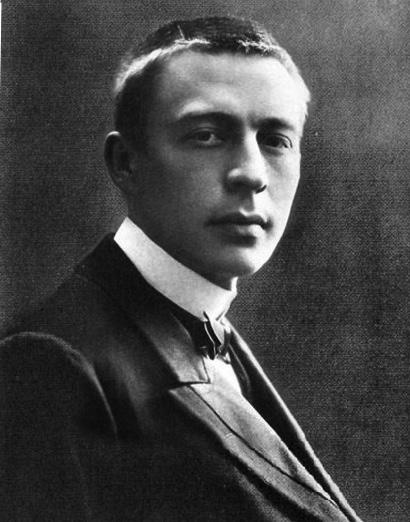
Born April 1, 1873; Semyonovo, Russia Died March 28, 1943; Beverly Hills, California
Symphony No. 1 in D Minor, Op. 13
the stint were shunned. . . . Here was a song that told you what happened to men who worked too fast: they died ugly deaths; their entrails fell on the ground. You sang the song slowly, you worked slowly, you guarded your life, or you died.
Rachmaninov would have become famous if he had done nothing but play the piano. But his true aspiration was to become a composer. At the Moscow Conservatory, his teacher Nikolai Zverev encouraged him to stick to the piano instead of writing music and resented his taking composition classes with Sergei Taneyev and Anton Arensky. After Rachmaninov tried his hand at composing some piano pieces—he even started an opera, Esmeralda—he realized that he was unable to choose between composition and performance, and so ultimately decided to pursue both (eventually becoming a fine conductor as well).
In 1889, the year he and Zverev parted ways, he sketched and abandoned a piano concerto, but the one he began the following year is his first major work—the one that became his op. 1. This is the score that sealed his fate as a composer, and it was completed in a rush of passion and elation, with Rachmaninov working from five in the morning until eight in the evening, and scoring the last two movements in just two and a half days. Rachmaninov played the first movement with orchestra in a concert of student works at the conservatory in March 1892. (He played it with the Chicago Symphony when he made his debut in Orchestra Hall on December 3, 1909—the first of his eight appearances with the Orchestra.)
Rachmaninov quickly began to draw attention as a composer. The brooding piano prelude in C-sharp minor he composed in 1892, at the age of nineteen, immediately became the calling card of a young artist’s dreams (and eventually a burden as well: audiences wouldn’t let him leave the stage until he played the work he eventually referred to dismissively as “it”). In 1893,
composed 1895
first performance March 27, 1897; Saint Petersburg, Russia
instrumentation three flutes and piccolo, two oboes, two clarinets, two bassoons, four horns, three trumpets, three trombones and tuba, timpani, triangle, cymbals, snare drum, bass drum, tam-tam, strings
approximate performance time 41 minutes
6 ONE HUNDRED FOUR TH SEASON COMMENTS
above: Sergei Rachmaninov, as a young man ca. 1892
opposite page: Postcard photograph of Fyodor Chaliapin and Rachmaninov, Genoa, Italy, ca. 1892
Tchaikovsky, who was already impressed with Rachmaninov’s talent, interrupted work on his final symphony, the Pathétique, to attend the premiere of Rachmaninov’s first opera, Aleko, based on Pushkin’s poem The Gypsies.
But the real mark of a nineteenth-century composer was the symphony. And so, at the age of twenty-two— and in the same decade as Tchaikovsky’s Pathétique, Brahms’s Fourth, Saint-Saëns’s Organ, Mahler’s First, Bruckner’s Eighth, and Dvořák’s New World— Rachmaninov set out to write a symphony. In truth, he had already tested the waters, first with an orchestral scherzo he wrote at the age of thirteen, then with an Allegro composed shortly after his first piano concerto. He was now ready to join the company of the great romantic symphonists, and as he began a new symphony in D minor, he was filled with excitement and assurance. Work went well, ideas came to him swiftly, and his enthusiasm did not wane.
But with the premiere of his First Symphony in Saint Petersburg in 1897, under the baton of the composer Alexander Glazunov, Rachmaninov’s confidence and momentum—if not his entire career—suddenly seemed to fizzle. The performance must have been appalling—Rachmaninov called it “the most agonizing hour of my life.” He hid in a stairwell, with his hands over his ears. (Glazunov was later said to have been drunk when he walked onstage.) And the opening-night review, by composer César Cui (the only member of the so-called Russian Five whose music is never performed today), could hardly have been worse—the symphony, Cui concluded, “would have brought ecstasy to the inhabitants of hell.”
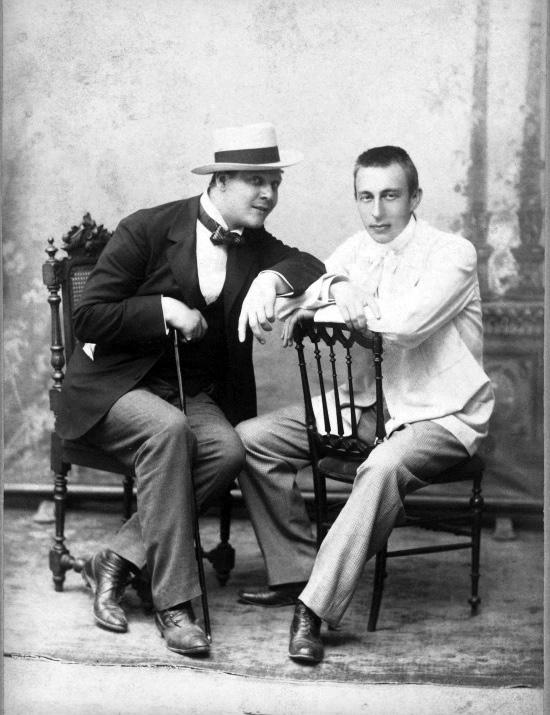
The audience response was scarcely warmer, though many listeners that night may have suspected what Rachmaninov had already learned the hard way: that, for all his prestige in Russian musical circles, Glazunov was a lousy
conductor. “How could so great a musician as Glazunov conduct so badly?” Rachmaninov later asked. “It is not even a question of his conducting technique, poor as that is, but of his musicianship; he beats time as if he had no feeling for music at all.” Nevertheless, the damage had been done, and Rachmaninov could not recover his nerve or his musical ambitions. Much later he recalled: “The despair that filled my soul would not leave me. My dreams of a brilliant career lay shattered. My hopes and confidence were destroyed.” Rachmaninov withdrew the symphony and refused to have it published, as if suppressing the score would also erase the memory.
For the next three years he wrote nothing— sketches for a new symphony were abandoned, and work on an opera, Francesca da Rimini, was shelved. He continued to perform, and even undertook a concert tour to London in 1898, but day after day, he found that he was unable to compose. As he grew more despondent, his friends began to recommend various remedies. Twice he visited Leo Tolstoy, once by himself and once with the bass Fyodor Chaliapin, hoping that contact with the great novelist would shake him out of his slump and jump-start his creativity, but the writer’s self-serving platitudes discouraged him even more. (“You must work,” Tolstoy told him. “I work every day.”) When he and Chaliapin performed one of Rachmaninov’s songs, Tolstoy wasted no words in conveying how much he disliked it.
Finally, fearing that Rachmaninov was trapped in a serious depression, his family suggested that he consult Dr. Nikolai Dahl, a Paris internist who had become a specialist in curing alcoholism through hypnosis. At the end of 1899, after months of almost daily sessions, Rachmaninov was again able to face the challenge of writing a large-scale orchestral work, and he began a
CSO.ORG/INSTITUTE 7 COMMENTS
new piano concerto. But, even with the wild success of his Second Piano Concerto—one of the most popular and beloved works in the form—the idea of composing a symphony still haunted and terrified him. When he did unveil a second symphony, ten years after the First, Rachmaninov swore it would be his last. Then, twenty-eight years later, he started work on the Third Symphony that did, in fact, turn out to be the final one of his career.
The four movements of Rachmaninov’s First Symphony are unified by a single idea, introduced immediately after the slow introduction to the first movement, that echoes the shape of the Dies irae—the familiar melody from the sequence for the Gregorian Mass for the Dead that would recur in several of Rachmaninov’s most important works over the years, including The Isle of the Dead. Each of the subsequent movements opens with a reference to this motto. The second-movement scherzo is fleet and light-footed. The expansive Larghetto is the prototype of the great slow movements in the symphonies and concertos yet to come. The finale is grand, festive, occasionally flamboyant, and sometimes menacing, and here Rachmaninov’s signature melody comes closest to actually quoting the Dies irae theme.
The entire score is strong, highly individual, and self-assured. It is the work of a young talent overflowing with ideas, not an artist paralyzed by failure.
Although Rachmaninov never destroyed his score of the First Symphony, leaving it behind when he left Russia to settle in the West, eventually it was given up for lost. After the composer’s death, a two-piano transcription of the symphony surfaced in Moscow, followed by a set of orchestral parts at the conservatory in Saint Petersburg. In March 1945, the symphony was performed in Moscow for the first time since its 1897 premiere. The Chicago Symphony Orchestra played it for the first time in February 2010.
—Phillip Huscher
above: A third version of Isle of the Dead, painted by Arnold Böcklin (1827–1901), dated 1883. Alte Nationalgalerie, Berlin
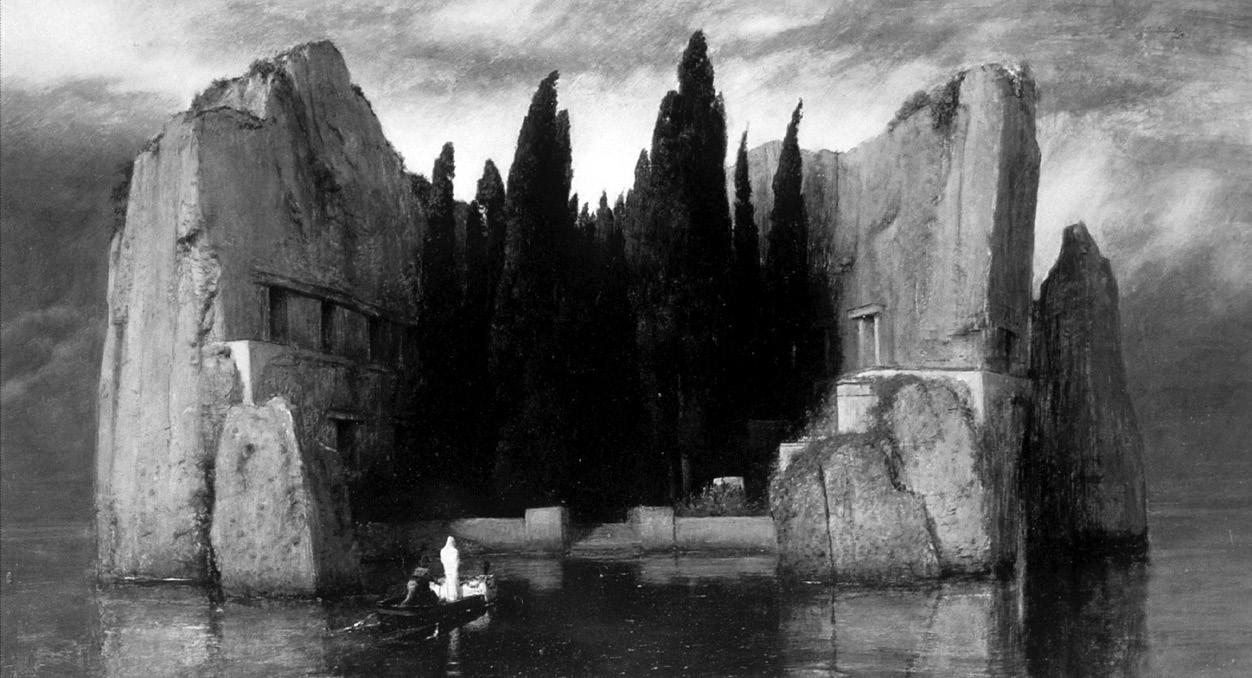
8 ONE HUNDRED FOUR TH SEASON COMMENTS
Phillip Huscher is the program annotator for the Chicago Symphony Orchestra.
music institute at the cso
The Negaunee Music Institute’s Lasting Partnership with the Irene Taylor Trust
In 1995, the family of the late Irene Taylor established a U.K.-based charity with the intent to bridge two fields about which she and her husband, Lord Chief Justice Peter Taylor, cared deeply: prison reform and music. Under the leadership of Artistic Director Sara Lee, the Irene Taylor Trust’s inaugural program, Music in Prisons, developed workshops to support prisoners in composing, performing, and recording original music.
For over twenty-five years, the trust has expanded with additional songwriting programs for at-risk young people and ex-prisoners, all with the goal of using collaborative music-making to help individuals develop confidence, transferable skills, and ambitions for the future.
teens incarcerated at the Illinois Youth CenterChicago, pregnant women and young parents through the Lullaby Project, and families that have lost children to gun violence through the Notes for Peace project. This season, projects take place at the Illinois Youth Center-Chicago, where youth will compose and perform original music supported by musicians of the Civic Orchestra of Chicago. Notes for Peace concluded its most recent project with a performance at Epiphany Center for the Arts on November 20 of seven new songs dedicated to the memory of those lost to gun violence.
“The Irene Taylor Trust has shown us the power of collaborative songwriting,” said Jonathan McCormick, director of education and the NMI. “Our work together over the years has enabled the CSOA to engage with and serve communities across Chicago in ways we never could have imagined or implemented on our own.”
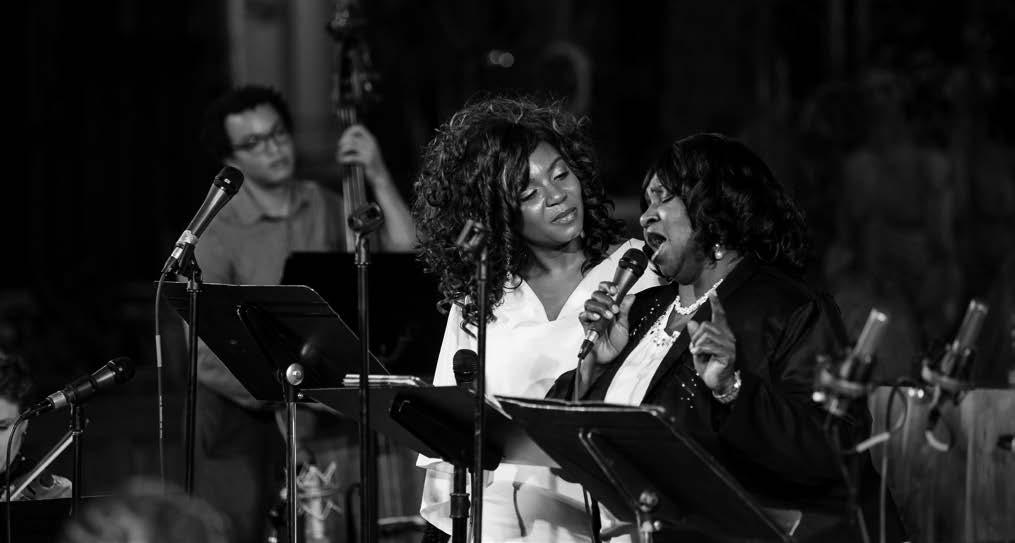
from left: A Notes for Peace performance by Purpose Over Pain member Patricia Porter. Sara Lee speaks to a group of young men at the Cook County Juvenile Temporary Detention Center.

The Irene Taylor Trust became a partner of the Negaunee Music Institute at the Chicago Symphony Orchestra in 2013, when Sara Lee and Nick Hayes of ITT joined NMI staff and musicians of the Chicago Symphony Orchestra for a weeklong songwriting project, modeled on the Music in Prisons program, with youth at the Cook County Juvenile Temporary Detention Center. In the years since, the partnership between the two organizations has yielded more than 150 original pieces of music, including songs written by
Adapted from “The Irene Taylor Trust, a longtime NMI partner, turns 25,” by Emily McClanathan, and available on cso.org/experience.
For more on the Negaunee Music Institute’s work with the Irene Taylor Trust, visit cso.org/nmi. These programs are generously sponsored by Megan and Steve Shebik, Lisa and Paul Wiggin, and Theodore and Elisabeth Wachs.
CSO.ORG/INSTITUTE 9
negaunee
PHOTOS BY TODD
ROSENBERG
Rossen Milanov Conductor
Respected and admired by audiences and musicians alike, Rossen Milanov is the music director of the Columbus Symphony Orchestra, Chautauqua Symphony Orchestra, Princeton Symphony Orchestra, and chief conductor of the RTV Slovenia Symphony Orchestra in Ljubljana.
Milanov has established himself as a conductor with considerable national and international presence. He completed a seven-year tenure as music director of the Orquesta Sinfónica del Principado de Asturias in Spain. Nationally, he has appeared with the Colorado, Detroit, Indianapolis, Milwaukee, Baltimore, Seattle, and Fort Worth symphonies and National Symphony Orchestra at the Kennedy Center, Link Up education projects with Carnegie Hall and the Orchestra of St. Luke’s, and with the Civic Orchestra of Chicago.
Internationally, he has collaborated with the BBC Symphony Orchestra, Orchestra de la Suisse Romande, and the Rotterdam Philharmonic; the Aalborg, Latvian, and Hungarian National symphony orchestras; and orchestras in Canada (Toronto, Vancouver), South Africa, Mexico, Colombia, and Brazil (São Paolo, Belo Horizonte). In the Far East, he has appeared with NHK, Sapporo, Tokyo, and Singapore symphonies; the Malaysian and Hong Kong philharmonics; and at the Hyogo Performing Arts Center.
Milanov has collaborated with some of the world’s preeminent artists, including Yo-Yo Ma, Itzhak Perlman, Joshua Bell, Midori, Christian Tetzlaff, and André Watts. During his eleven-year tenure with the Philadelphia Orchestra, Milanov conducted more than 200 performances. In 2015, he completed a fifteen-year tenure as music director of the nationally recognized training
orchestra Symphony in C in New Jersey, and in 2013 a seventeen-year tenure with the New Symphony Orchestra in his native city of Sofia, Bulgaria. His passion for new music has resulted in world premieres of works by composers such as Derek Bermel, Mason Bates, Caroline Shaw, Philip Glass, Richard Danielpour, Nicholas Maw, and Gabriel Prokofiev, among others.
Noted for his versatility, Milanov is a welcome presence in the worlds of opera and ballet. He has collaborated with Komische Oper Berlin (Shostakovich’s Lady Macbeth of Mtsensk), Ópera de Oviedo with the Spanish premiere of Tchaikovsky’s Mazeppa and Bartók’s Bluebeard’s Castle (honored as best Spanish production for 2015), and Opera Columbus (Verdi’s La traviata).
An experienced ballet conductor, he has worked at New York City Ballet and collaborated with some of the best-known choreographers of our time, such as Mats Ek, Benjamin Millepied, and Alexei Ratmansky in the critically acclaimed revival of Swan Lake in Zurich with Zurich Ballet and in Paris with La Scala Ballet.
Milanov was a recipient of the Columbus Performing Arts Prize from the Columbus Foundation. Under his leadership, the symphony has expanded its reach by connecting original programing with community-wide initiatives, such as a focus on women composers and nature conservancy, original festivals, and new-music commissions.
In Princeton, he recently celebrated his tenth anniversary as music director by collaborating with creative artists such as Daniel Rowland, Inon Barnatan, Rachel Barton Pine, and Derek Bermel. Under his leadership, the orchestra has established an excellent artistic reputation and has been recognized for its innovation and vital role in the community.
Rossen Milanov studied conducting at the Curtis Institute of Music and the Juilliard School, where he received the Bruno Walter Memorial Scholarship. A passionate chef, he often dedicates his culinary talents to various charities.
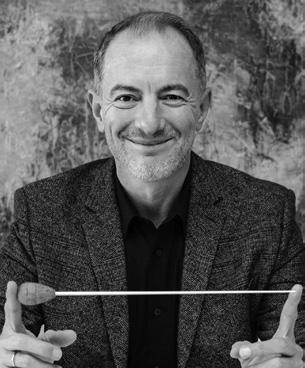
10 ONE HUNDRED FOUR TH SEASON
profiles
Civic Orchestra of Chicago
Founded in 1919 by Frederick Stock, second music director of the Chicago Symphony Orchestra (CSO), the Civic Orchestra of Chicago prepares emerging professional musicians for lives in music. Civic members participate in rigorous orchestral training, September through June each season, with the Robert Kohl and Clark Pellett Principal Conductor Ken-David Masur, musicians of the CSO, and some of today’s most luminary conductors including the CSO’s Zell Music Director Riccardo Muti.
The importance of the Civic Orchestra’s role in Greater Chicago is underscored by its commitment to present concerts of the highest quality at no charge to the public. In addition to the critically acclaimed live concerts at Symphony Center, Civic Orchestra performances can be heard locally on WFMT (98.7 FM).
Civic musicians also expand their creative, professional, and artistic boundaries and reach diverse audiences through educational performances at Chicago Public Schools and a series of chamber concerts at various locations throughout the city, including Chicago Park District field houses and the National Museum of Mexican Art.
To further expand its musician training, the Civic Orchestra launched the Civic Fellowship program in the 2013–14 season. Each year ten to
fifteen Civic members are designated as Civic Fellows and participate in intensive leadership training that is designed to build and diversify their creative and professional skills.
From 2010 to 2019, Yo-Yo Ma was a leading mentor to Civic musicians and staff in his role as CSO Judson and Joyce Green Creative Consultant, and the programs and initiatives he established are integral to the Civic Orchestra curriculum today. Civic Orchestra musicians develop as exceptional orchestral players and engaged artists, cultivating their ability to succeed in the rapidly evolving world of music in the twenty-first century.
The Civic Orchestra’s long history of presenting full orchestra performances free to the public includes annual concerts at the South Shore Cultural Center (in partnership with the South Shore Advisory Council) as well as numerous Chicago Public Schools. The Civic Orchestra is a signature program of the Negaunee Music Institute at the Chicago Symphony Orchestra, which offers a wide range of education and community programs that engage more than 200,000 people of diverse ages, incomes, and backgrounds each year, in Chicago and around the world.
For more on the Civic Orchestra of Chicago and its Principal Conductor Ken-David Masur, please visit cso.org/civic.
CSO.ORG/INSTITUTE 11 PROFILES
*
Civic Orchestra of Chicago
Ken-David Masur Principal Conductor
The Robert Kohl and Clark Pellett Principal Conductor Chair
violins
Subin Shin
Dylan Marshall Feldpausch* Matthew Weinberg Jesus Linarez Gabriela Lara Marian Antonette Mayuga* Sungjoo Kang Kenichi Kiyama Crystal Qi Janani Sivakumar Hee Woo Seo Robbie Herbst Diane Yang* Joy Curtin+ Hannah Hsu
Annie Pham Ran Huo Yu-Kun Hsiang Jonah Kartman Kristian Brusubardis Nelson Mendoza Hernandez* Grace Walker
Valentina Guillen Menesello Kina Ono Emily Nardo Kimberly Bill Hee Yeon Kim* Liya Ma Shin Lan
violas
Aditi Prakash Amanda Kellman Derrick Ware Josephine Stockwell Kunjing Dai Larissa Mapua Megan Yeung Pedro Mendez Siyang Calvin Dai Stephanie Block Taisiya Sokolova+ Teddy Schenkman*
cellos
Abby Monroe Annamarie Wellems Charlotte Ullman Francisco Malespin* Haley Slaugh Hana Takemoto Jaime An Lidanys Graterol Lindsey Sharpe* Miles Link
basses
Ben Foerster Bennet Norris Caleb Edwards Hannah Novak Leo Finan Nathan Beaver Olivia Reyes Victor Stahoviak
flutes Aalia Hanif Katarina Ignatovich Madison Booth
oboes Andrew Port* James Jihyun Kim Oliver Talukder
clarinets Antonio Garrasi Daniel Solowey bassoons Liam Jackson Mackenzie Brauns* Seo Young (Michelle) Min
horns
Jacob Medina Michael Stevens Nelson Yovera Perez Ryan Williamson Sylvia Denecke
trumpets Isaac Hopkins Ismael Cañizares Ortega Joshua Harris Michael Leavens trombones Felix Regalado Hugo Saavedra Arciniegas*
bass trombone Alexander Mullins
tuba Ben Poirot timpani David Miller
percussion Benjamin Krauss+ Charley Gillette George Tantchev John Ringor Tomas Leivestad librarian Anna Thompson
12 ONE HUNDRED FOUR TH SEASON PROFILES
Civic Orchestra Fellow + Civic Orchestra Alumni
negaunee music institute at the cso
the board of the negaunee music institute
Leslie Burns Chair
Liisa Thomas Vice Chair
John Aalbregtse
David Arch
James Borkman
Jacqui Cheng
Ricardo Cifuentes
Richard Colburn
Charles Emmons
Judy Feldman
Lori Julian
Rumi Morales
Mimi Murley Margo Oberman
Gerald Pauling
Harper Reed
Veronica Reyes
Steve Shebik
Marlon Smith
Eugene Stark
Ex-officio Members
Jeff Alexander Jonathan McCormick
Vanessa Moss
civic orchestra artistic leadership
Coaches from the Chicago Symphony Orchestra
Robert Chen Concertmaster
The Louis C. Sudler Chair, endowed by an anonymous benefactor Baird Dodge Principal Second Violin Danny Lai Viola
Max Raimi Viola
John Sharp Principal Cello
The Eloise W. Martin Chair
Kenneth Olsen Assistant Principal Cello
The Adele Gidwitz Chair
Richard Hirschl Cello Daniel Katz Cello
Brant Taylor Cello
Alexander Hanna Principal Bass
The David and Mary Winton Green Principal Bass Chair
Stefán Ragnar Höskuldsson Principal Flute
The Erika and Dietrich M. Gross Principal Flute Chair
Emma Gerstein Flute
Jennifer Gunn Flute and Piccolo
The Dora and John Aalbregtse Piccolo Chair
William Welter Principal Oboe
The Nancy and Larry Fuller Principal Oboe Chair
Stephen Williamson Principal Clarinet
John Bruce Yeh Assistant Principal Clarinet and E-flat Clarinet
Keith Buncke Principal Bassoon William Buchman Assistant Principal Bassoon
David Cooper Principal Horn Daniel Gingrich Associate Principal Horn Esteban Batallán Principal Trumpet
The Adolph Herseth Principal Trumpet Chair, endowed by an anonymous benefactor Mark Ridenour Assistant Principal Trumpet Michael Mulcahy Trombone John Hagstrom Trumpet
The Bleck Family Chair
Tage Larsen Trumpet
Charles Vernon Bass Trombone
Gene Pokorny Principal Tuba
The Arnold Jacobs Principal Tuba Chair, endowed by Christine Querfeld
David Herbert Principal Timpani
The Clinton Family Fund Chair
Vadim Karpinos Assistant Principal Timpani, Percussion
Cynthia Yeh Principal Percussion
Sarah Bullen Former Principal Harp
Mary Sauer Former Principal Keyboard Peter Conover Principal Librarian
negaunee music institute at the cso
Jonathan McCormick Director, Education & the Negaunee Music Institute
Katy Clusen Senior Manager, School & Family Programs
Antonio Padilla Denis Manager, Civic Orchestra of Chicago Rachael Cohen Coordinator, Institute Programs
Emory Freeman Operations Coordinator, Civic Orchestra of Chicago Autumn Stolle Institute Programs Assistant
Frances Atkins Content Director Kristin Tobin Designer & Print Production Manager
CSO.ORG/INSTITUTE 13
honor roll of donors
Negaunee Music Institute at the
Chicago Symphony Orchestra
The Negaunee Music Institute connects individuals and communities to the extraordinary musical resources of the Chicago Symphony Orchestra. The following donors are gratefully acknowledged for making a gift in support of these educational and engagement programs. To make a gift or learn more, please contact Kevin Gupana, Associate Director of Giving, Educational and Engagement Programs, 312-294-3156.
$150,000 AND ABOVE
The Julian Family Foundation The Negaunee Foundation
$100,000–$149,999
Allstate Insurance Company The Elizabeth F. Cheney Foundation
$75,000–$99,999
John Hart and Carol Prins Megan and Steve Shebik
$50,000–$74,999
Robert and Joanne Crown Income Charitable Fund
Lloyd A. Fry Foundation Judy and Scott McCue Nancy Lauter McDougal and Alfred L. McDougal †
Polk Bros. Foundation
Barbara and Barre Seid Foundation Shure Charitable Trust Michael and Linda Simon Mr. Irving Stenn, Jr.
$35,000–$49,999
Kinder Morgan Bowman C. Lingle Trust National Endowment for the Arts
$25,000–$34,999
Anonymous Abbott Fund Barker Welfare Foundation Crain-Maling Foundation The James and Madeleine McMullan Family Foundation
$20,000–$24,999
Anonymous Richard P. and Susan Kiphart Family PNC
Charles and M. R. Shapiro Foundation
The George L. Shields Foundation, Inc.
$15,000–$19,999
Carey and Brett August
The Buchanan Family Foundation Bruce and Martha Clinton for The Clinton Family Fund Sue and Jim Colletti Ellen and Paul Gignilliat Mary Winton Green Illinois Arts Council Agency
The League of the Chicago Symphony Orchestra Association Mr. Philip Lumpkin
Sandra and Earl Rusnak, Jr. Ms. Liisa M. Thomas and Mr. Stephen L. Pratt Lisa and Paul Wiggin Dr. Marylou Witz
$11,500–$14,999
Nancy A. Abshire Robert & Isabelle Bass Foundation, Inc. Mr. † & Mrs. David A. Donovan Mrs. Carol Evans, in memory of Henry Evans Jim and Ginger Meyer Ksenia A. and Peter Turula Theodore and Elisabeth Wachs
$7,500–$11,499
Anonymous (2) Robert H. Baum and MaryBeth Kretz Mr. Lawrence Belles Mr. Lawrence Corry Mr. & Mrs. † Allan Drebin Nancy and Bernard Dunkel Ms. Nancy Felton-Elkins and Larry Elkins Mr. & Mrs. Robert Geraghty Mr. & Mrs. Joseph B. Glossberg Chet Gougis and Shelley Ochab Halasyamani/Davis Family Robert Kohl and Clark Pellett Mr. Glen Madeja and Ms. Janet Steidl Ling Z. and Michael C. Markovitz Drs. Robert and Marsha Mrtek Ms. Susan Norvich D. Elizabeth Price COL (IL) Jennifer N. Pritzker, IL ARNG (Retired) Robert E. † and Cynthia M. † Sargent Carol S. Sonnenschein
$4,500–$7,499
Anonymous Joseph Bartush John D. and Leslie Henner Burns Ms. Marion A. Cameron-Gray Ann and Richard Carr Harry F. and Elaine Chaddick Foundation
Italian Village Restaurants Mr. & Mrs. Stan Jakopin Dr. June Koizumi Dr. Lynda Lane Margo and Michael Oberman
Dr. Scholl Foundation
Jessie Shih and Johnson Ho Dr. Nanajan Yakoub
$3,500–$4,499
Charles H. and Bertha L. Boothroyd Foundation Mr. & Ms. Keith Clayton Dr. Edward A. Cole and Dr. Christine A. Rydel Dr. Ronald L. Hullinger Ms. Ethelle Katz Dr. Leo and Catherine Miserendino
$2,500–$3,499 Ms. Sandra Bass Mr. Douglas Bragan Patricia A. Clickener Mr. & Mrs. Dwight Decker Ms. Paula Elliott Brooks and Wanza Grantier William B. Hinchliff Mrs. Gabrielle Long Mr. Zarin Mehta David † and Dolores Nelson Benjamin J. Rosenthal Foundation David and Judith L. Sensibar Margaret and Alan Silberman Mr. Larry Simpson Ms. Mary Walsh Mr. Kenneth Witkowski
$1,500–$2,499
Dora J. and R. John Aalbregtse Richard J. Abram and Paul Chandler Mr. Edward Amrein, Jr. and Mrs. Sara Jones-Amrein Ms. Marlene Bach Mr. Carroll Barnes Mr. & Mrs. William E. Bible Ms. Danolda Brennan Bradley Cohn Elk Grove Graphics Charles and Carol Emmons Dr. & Mrs. Sanford Finkel, in honor of the Civic horn section Mrs. Roslyn K. Flegel David and Janet Fox Camillo and Arlene Ghiron Amber Halvorson James and Megan Hinchsliff Ms. Sharon Flynn Hollander Michael and Leigh Huston Bob and Marian Kurz
Dona Le Blanc Dr. Herbert and Francine Lippitz Ms. Molly Martin Mr. Aaron Mills Mr. & Mrs. Dennis Moffat Mrs. Frank Morrissey Edward and Gayla Nieminen Dianne M. and Robert J. Patterson, Jr. Mr. & Mrs. Jeffery Piper
† Deceased
Italics indicate individual or family involvement as part of the Trustees or Governing Members of the Chicago Symphony Orchestra Association. Gifts listed as of November 2022
14 ONE HUNDRED FOUR TH SEASON
Erik and Nelleke Roffelsen
Ms. Cecelia Samans
Mr. David Samson Ms. Denise Stauder Mr. & Mrs. Salme Steinberg Walter and Caroline Sueske Charitable Trust Mr. Peter Vale Abby and Glen Weisberg M.L. Winburn
$1,000–$1,499 Anonymous (4) David and Suzanne Arch Jon W. and Diane Balke
Mr. & Mrs. John Barnes Howard and Donna Bass
Marjorie Benton Ann Blickensderfer
Mr. Thomas Bookey Mr. James Borkman
Mr. Donald Bouseman
Mr. Lee M. Brown and Ms. Pixie Newman Ms. Jeanne Busch
Robert and Darden Carr Drs. Virginia and Stephen Carr Mr. Rowland Chang
Lisa Chessare
Mr. Ricardo Cifuentes
Mr. & Mrs. Bill Cottle
In Memory of Ira G. Woll Constance Cwiok
Mr. Adam Davis
Mr. & Mrs. Barnaby Dinges Mr. & Mrs. Robert Dulski
Mr. Clinton J. Ecker and Ms. Jacqui Cheng Judith E. Feldman
Ms. Lola Flamm
Arthur L. Frank, M.D. Mr. Robert Frisch
Peter Gallanis
Enid Goubeaux
Mr. & Mrs. John Hales Dr. Robert A. Harris Dr. & Mrs. Jerome Hoeksema
Mr. Matt James Mr. Randolph T. Kohler
Mr. Steven Kukalis
Ms. Foo Choo Lee
Dr. & Mrs. Stuart Levin
Diane and William F. Lloyd Mr. † & Mrs. Gerald F. Loftus
Sharon L. Manuel
Mr. & Mrs. Stephen Morales Mrs. MaryLouise Morrison
Catherine Mouly and LeRoy T. Carlson, Jr. Mr. George Murphy
Mr. Bruce Oltman
Ms. Joan Pantsios
Mr. & Mrs. Gerald L. Pauling II Kirsten Bedway and Simon Peebler
Quinlan & Fabish
Susan Rabe
Dr. Hilda Richards
Mary K. Ring
Christina Romero and Rama Kumanduri
Mr. Nicholas Russell †
Gerald and Barbara Schultz
Mr. & Mrs. Thomas Scorza Stephen A. and Marilyn Scott
Jane A. Shapiro
Mr. & Mrs. James Shapiro
Richard Sikes
Dr. Sabine Sobek
Dr. & Mrs. R. Solaro
Sharon Swanson
Ms. Joanne Tarazi Ms. Joanne C. Tremulis
Mr. & Ms. Terrence Walsh Ms. Zita Wheeler
William Zeng
Irene Ziaya and Paul Chaitkin
ENDOWED FUNDS
Anonymous (3)
Cyrus H. Adams Memorial Youth Concert Fund
Dr. & Mrs. Bernard H. Adelson Fund Marjorie Blum-Kovler Youth Concert Fund CNA
The Davee Foundation
Frank Family Fund
Kelli Gardner Youth Education Endowment Fund
Mary Winton Green William Randolph Hearst Foundation Fund for Community Engagement
Richard A. Heise
Peter Paul Herbert Endowment Fund
Julian Family Foundation Fund
The Kapnick Family
Lester B. Knight Charitable Trust
The Malott Family School Concerts Fund
The Eloise W. Martin Endowed Fund in support of the Negaunee Music Institute at the Chicago Symphony Orchestra
The Negaunee Foundation
Nancy Ranney and Family and Friends Shebik Community Engagement Programs Fund
Toyota Endowed Fund
The Wallace Foundation Zell Family Foundation
CIVIC ORCHESTRA OF CHICAGO SCHOLARSHIPS
Members of the Civic Orchestra receive an annual stipend to help offset some of their living expenses during their training in Civic. The following donors have generously underwritten a Civic musician(s) for the 2022–23 season.
Eleven Civic members participate in the Civic Fellowship program, a rigorous artistic and professional development curriculum that supplements their membership in the full orchestra. Major funding for this program is generously provided by The Julian Family Foundation
Nancy A. Abshire
Amanda Kellman, viola
Dr. † & Mrs. † Bernard H. Adelson Megan Yeung, viola
Mr. Lawrence Belles and The Elizabeth F. Cheney Foundation+ Michael Stevens, horn
Sue and Jim Colletti Hee Yeon Kim,** violin
Lawrence Corry Jonah Kartman, violin
Robert and Joanne Crown Income Charitable Fund
Irina Chang, clarinet Kunjing Dai, viola Antoni Garrasi, clarinet James Jihyun Kim, oboe David Miller, timpani Bennett Norris, bass
Mr. † & Mrs. David A. Donovan Jacob Medina, horn
Mr. & Mrs. † Allan Drebin and The Elizabeth F. Cheney Foundation Benjamin Foerster, bass
Mr. & Mrs. Paul C. Gignilliat Larissa Mapua, viola
Mr. & Mrs. Joseph B. Glossberg Michael Leavens, trumpet
Richard and Alice Godfrey Robbie Herbst, violin
Chet Gougis and Shelley Ochab Liam Jackson, bassoon
† Deceased ** Civic Orchestra Fellow + Partial Sponsor Italics indicate individual or family involvement as part of the Trustees or Governing Members of the Chicago Symphony Orchestra Association. Gifts listed as of November 2022
CSO.ORG/INSTITUTE 15
Mary Winton Green Victor Stahoviak, bass
Jane Redmond Haliday Chair Hana Takemoto, cello
The Julian Family Foundation Nelson Mendoza,** violin Ryan Williamson, horn
Lester B. Knight Charitable Trust Jaime An, cello Isaac Hopkins, trumpet Miles Link, cello Jake Platt, bass Crystal Qi, violin
League of the Chicago Symphony Orchestra Association Lindsey Sharpe,** cello
Leslie Fund Inc. Aalia Hanif, flute Francisco Malespin,** cello
Phillip G. Lumpkin Dylan Feldpausch,** violin
Mr. Glen Madeja and Ms. Janet Steidl Abigail Monroe, cello
Judy and Scott McCue Andrew Port,** oboe
Nancy Lauter McDougal and Alfred L. McDougal † Emily Nardo, violin
Dr. Leo and Catherine Miserendino Olivia Reyes, bass
Ms. Susan Norvich Nick Collins, tuba Benjamin Poirot, tuba
Sandra and Earl J. Rusnak, Jr. Sylvia Denecke, horn
Barbara and Barre Seid Foundation Alexander Mullins, bass trombone Hugo Saavedra,** trombone
The George L. Shields Foundation Inc.
Stephanie Block, viola Laura Schafer, violin Haley Slaugh, cello
The David W. and Lucille G. Stotter Chair Grace Walker, violin
Ruth Miner Swislow Charitable Fund Kimberly Bill, violin
Lois and James Vrhel Endowment Fund Caleb Edwards, bass
Dr. Marylou Witz Marian Mayuga,** violin
Anonymous Diane Yang,** violin
Anonymous Kina Ono, violin
† Deceased ** Civic Orchestra Fellow + Partial Sponsor HONOR ROLL OF DONORS











